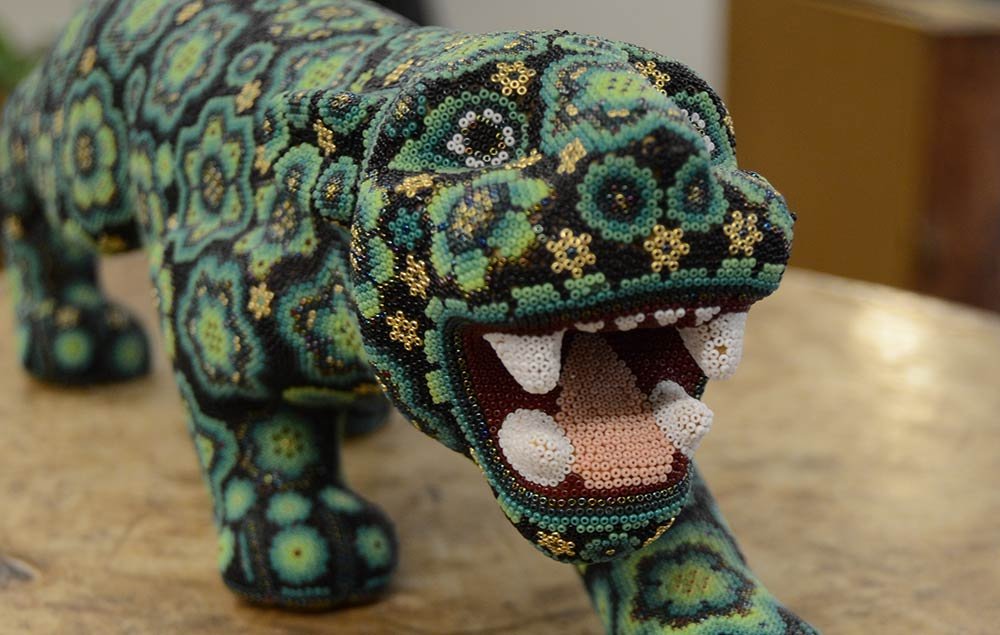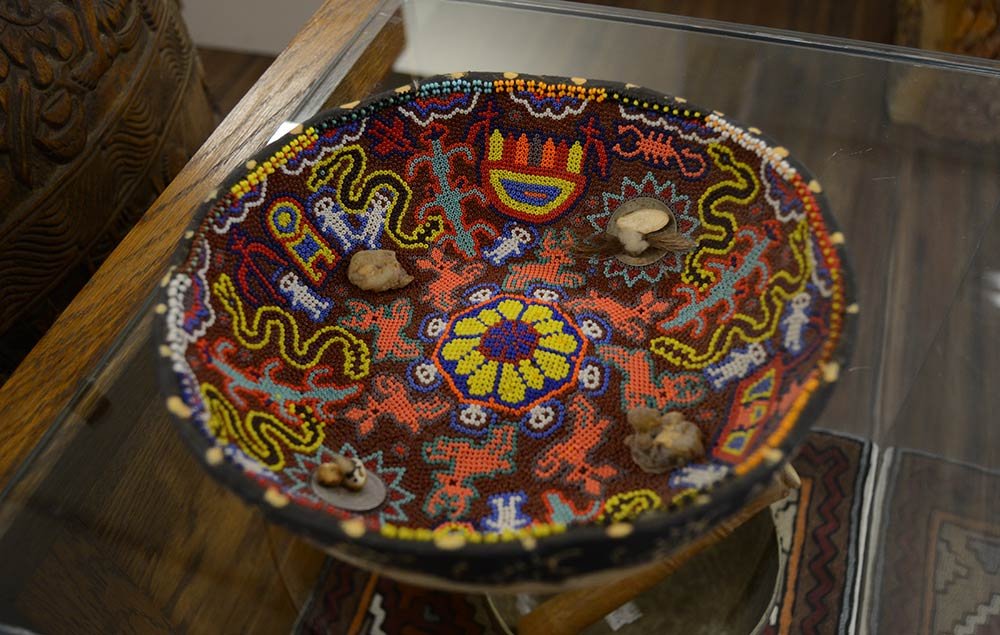The Huichol Indians
Along the borders of the States of Jalisco and Nayarit, Mexico, in the mountains of the Sierra Madre Occidental, live an indigenous tribe of unique and magical people: The Huichols. Because of the extreme remoteness of the territory, the Huichols were not conquered by the Spanish invaders nor greatly changed by the Mexican culture. The Huichols are becoming increasingly known, yet they remain little understood. They are a cultural group who live today much as theyhave in the past but are beginning to feel the pressures of our modern world more acutely. Though they are perhaps best known for their vivid, colorful yarn paintings, they have traditionally produced a wealth of religious objects andceremonial costumes for use within their own culture. Therefore, they live today very much as they did centuries ago and are considered by many anthropologists to be an invaluable “window” into the ancient past of the Americas. Often the Huichol are referred to as “magical”, in part because of the mystical quality of their healing powers. The Huichol today number about 10,000.
A Deeply Spiritual People
A deeply religious people whose beliefs encompass every aspect of life, they worship multiple deities, most of which represent life forces: earth, water, fire, wind, sun, and moon, among others. Religion and the Arts are inextricably intertwined in Huichol life; therefore, often their deities and ceremonies are incorporated into their art. The Huichol are a deeply spiritual people, a glimpse of an age when people stepped more lightly upon the earth. The growing familiarity with Huichol art and culture has been beneficial. It has created a demand among collectors for the art, providing the Huichols more work at home, thereby helping to maintain strong family and community ties.
Traditions and Mythology in Art
Through their art, the Huichols share with us segments of their traditions and mythology. Some of the deities most often portrayed are the Deer (God of fertility and brother to the Peyote); the Peyote (God of knowledge and the center of their religion); the Eagle (God of life); the Snake (used in prayers for rain); “Flower” motifs (appearing in many forms, often depicting the sacred Peyote or the corn flower); and Scorpions (considered to be small messengers from the Gods). If stung by a scorpion, it is believed that the Gods are saying there is something the victim is neglecting. If allowed to survive the sting, servitude in the Holy House must be done to make amends.
One artist in particular uses Mexican peso coins in his art, because the motifs on the peso, the eagle with a snake in its mouth (Gods of Life and Rain), are symbols important to the Huichols. Often incorporated in the same pieces will be deer tail (for fertility), cotton tufts (for rain clouds), and the seeds of the primary crops grown in the Sierra (corn, squash, and beans). Stones are also sometimes used to represent ancestors. All represent prayers asking the Gods to grant ample rain and life forces for a fertile, bountiful harvest. The ancestors are asked assist in petitioning the favor of the Gods.
The Huichols’ beliefs are complex and elaborate, involving myth, shamanism, ritual, peyote, prayer and ceremony. As a people they esteem creativity and beauty both internally and externally, seeking to always be a reflection of the gods they worship. Their ethereal eyes smile beneath wide brimmed hats adorned with beads. Crisp white cotton blouses are enlivened by brightly embroidered sashes and bags, their waists are cinched by a symbolic construction of woolen embroidered belts. Much of their current art depicts these religious themes and retells mystical stories. Therefore, each piece of Huichol art, in addition to being a beautiful work of art, carries its own historical and spiritual significance.
Peyote, a hallucinogenic, mandala-shaped cactus that grows in the desert in north-central Mexico, is the center around which the lives and art of the Huichol Indians revolve. Through the ritual use of peyote, the Huichol tap into a reservoir of ancient knowledge, insights that arise to reveal the deepest secrets of the universe.
Visions divined during the annual pilgrimage to the sacred land of the Huichol, the peyote desert in San Luis Potosi, are the source of the symbols that find their way into Huichol art. The insights are considered a gift of the gods, divine moments of illumination bestowed only on those most worthy. The dreams transport one out of the ordinary and into the inner realms of knowledge and power. Animals, particularly deer, act as their spirit guides. The Huichols’ art is the vehicle to encode the sacred information received. Whether depicted in beds or woven into a yarn painting, the symbols are universally understood by all members of their culture.
The following is a partial list of symbols as described by Susane Eger Valadez in her book “Huichol Indian Sacred Rituals”:
The deer is the backbone of the culture, the symbol of the spirit guide “kayumahli”, who leads individuals through the landscape of peyote visions, teaching them. How to access the shamanic knowledge they seek to discover. Shaman depend on the deer spirits to convey messages for them, to and from the spirit world while performing rituals and ceremonies.
Peyote mandalas appear as kaleidoscope patterns, often in the center of masks, gourd bowls, yarn paintings, and other forms of art. Mandalas are the “doorways” to the spirit world. They take the form in art of round discs or mirrors, symbolizing the visions experienced during peyote experiences.
Birds, highly esteemed, are believed to be direct messengers to the gods. Tail and wing feathers are often used by the shaman for healing, communicating with the spirit world, rainmaking, and accompanying ceremonial songs and chants.
Snakes are the intermediaries between humans and the spirit world. They teach shaman to become healers. Snakes also assist the rain goddess, as the Huichol believe rain consists of millions of small snakes. Snakes are highly regarded for their work in the corn fields eating rodents and other pests harmful to the corn harvest.
The sun, “Tao Greek”, is the Father Sun, master of the heavens who brings light and illumination to the world. His wife is the eagle, mother of the sky and goddess of life. The sun provides power for all living things.
Salamanders are related to water and rain, an agent of Rain Mother, helping to stir up clouds and make rain fall.
Ceremonial Arrows, “Uru”, are the most common offerings. By analogy with the flight of birds, they represent a message to the deities. These arrows are also used in sorcery as well as in curing. The essential part of the arrow consists of a bamboo shaft into which a long piece of hardwood is inserted. The rear shaft is decorated with painted bands, often of different colors for the different deities. Feathers of birds belonging to the particular god to whom the arrow is to be given are attached to the rear shaft along with symbolic objects, often woven or embroidered on pieces of manta, asking for some particular favor – generally good health, rain, and material benefits. These arrows, which are some 9 to 12 inches in length, are not to be confused with the “Muvieri”, or shaman’s arrow, used in curing and other ritual purposes. The “Muvieri” always have eagle or hawk feathers attached to the rear shaft, as these birds fly higher than any other.
The votive bowls, “Rukuri”, are fashioned from the bottom section of gourds, often of the same type as those used to hold drinking water. Beeswax is applied to the inside to hold various symbolic objects, including grains of corn, tufts of cotton, coins, and beads arranged in designs to represent, for example, deer and human figures. The bowls vary in diameter from 2 to 6 inches. Figures fashioned out of beeswax are often stuck to the inside of the bowl. The number of beads stuck into these figures depends on the wealth of the individual and on the importance of the offering. Each piece is made by a single person. The vow to hold a ceremony is sometimes symbolically represented in the bowl.
The “Tsikuiri”, or gods eyes, consist of a framework of two sticks tied together to form a cross – probably representing the gods of the four cardinal directions – and colored yarn wound to form one, but sometimes more, diamond-shaped figures. The offering symbolically asks the particular deity to “keep an eye” on the individual. These “Tsikuri” are most prominent in the harvest festival, during which the children are taken on a pretended peyote pilgrimage by the songs of the officiating “Tsauririka”. The songs introduce the children to the various deities who live along the road of their pilgrimage to “Wirikuta”, so that these gods will recognize the children and keep them from harm. Every child is supposed to participate in this ceremony for 5 years. The number of yarn diamonds on his or her “Tsikuri” represents the number of times the child was taken on the pretended pilgrimage.
Stylized front shields, or “Neaika”, are round or polygonal weavings, some 2 to 8 inches in diameter, with pieces of bamboo or sticks to hold colored yarn. The symbolic designs ask favors from the deities to whom they are offered. The shield as a whole symbolized the face or aspect of a god and is usually attached to a prayer arrow. In a larger sense, a “Nearika” may be defined as an instrument for seeing the invisible and for conjuring up sacred ancestors.
The beaded bells are called “Corazon de Vida”. The Huichols say you have one in your home, and each year you add another ribbon to ensure good health and prosperity to your family.
The Huichol also create many magnificent pieces, for example the rattles and masks on display, specifically for commercial sales. Those destined for sale tend to be larger, with the inside, or outside, covered with wax so that it can be completely lined with beads arranged in various patterns. The patterns typically recall specific images revealed through their peyote pilgrimage, or other images symbolically representing their religious life, their culture and their mythologies. Because rain is one of the main preoccupations of the Huichol, much of their beadwork, embroidery, and weaving depict flowers, since flowers bloom only during the brief rainy season and they probably represent prayers by association. Snakes, lizards, and other creatures most likely serve a similar purpose.






